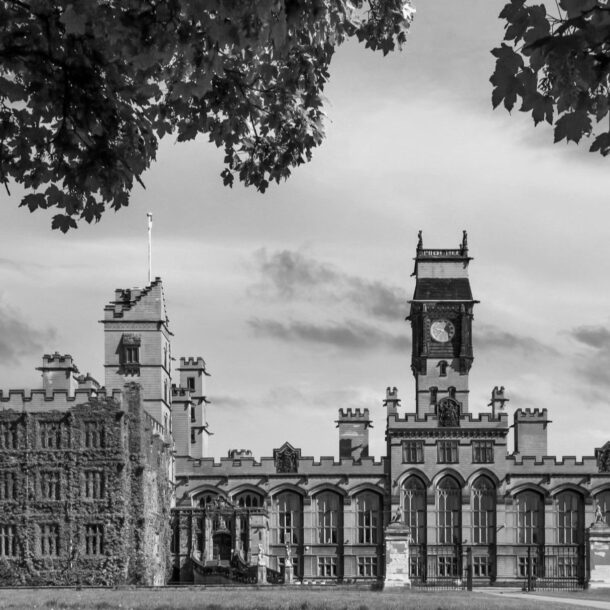

Close

Henry de Beaumont was the son of a wealthy French noble family with ties to the royal families of Castile and France. Through skill in battle and royal patronage, he forged a place for himself and his family in the English nobility. His direct descendents include the current owners of Carlton Towers. His unrelenting obsession with invoking his right to the vast lands and immense wealth of the Earldom of Buchan in the northeast of Scotland defined his life and spurred England into a decades-long attempt to subjugate its northern neighbor. The Wars of Scottish Independence lasted 32 years from 1286 to 1357, and Beaumont fought in every significant battle.
Beaumont had a privileged place in the English royal court because he was a cousin of Edward I’s Spanish wife, Eleanor of Castil. He served as a knight of the royal household and grew up alongside the future Edward II. Beaumont gained his first military experience as a teenager fighting alongside an aged Edward I in Flanders against the French. When Edward I led his men into Scotland in 1298 in a gambit to seize Scotland, Beaumont was at his side once again. As a young soldier, his mistakes built the strategic mind that he fine-tuned over decades of war and bloodshed. In this period, England and Scotland were entangled in a series of wars and invasions. Scottish affairs had been thrown into chaos even since the country’s child queen died with no apparent heir. Edward I claimed the Scottish crown because Margaret had been betrothed to his son, but the Scots vehemently resisted any threat to their independence. At the Battle of Falkirk, the Scots fought in dense, 1000-men schiltrons, or phalanxes of dense shielded men wielding pikes like massive, murderous hedgehogs. Beaumont was a young knight heedles of the caution that comes with experience. He drove ahead blindly until one of the Scottish pikes pierced and killed his horse. He fell to the ground, his leg perhaps still pinned below his massive warhorse. He would have had to flee on foot bearing the full weight of a Medieval knight’s armor to save himself from the fateful march of the Scottish schiltron. He survived, and despite his personal setback, the English won the battle.
When Edward II became king, he aided his childhood friend. He granted Beaumont significant swaths of land in England and arranged his marriage to Alice Comyn, the sole heir of John Comyn, Earl of Buchan, who had held a sprawling estate in the northeast of Scotland. Beaumont saw the tantalizing possibility of a vast feudal estate just within reach, but politics intervened. Unfortunately for Beaumont, Anne Comyn became irrevocably English in the eyes of the Scots as soon as she married him. The Scottish lords refused to acknowledge his right to the Earldom of Buchan. Moreover, John Comyn had resisted Robert the Bruce, the Scotsman whose claim to the crown prevailed because of his victories in battle. Robert the Bruce pillaged and burned the land of Buchan, forcing the populace to reject any loyalty to the Comyn family and accept him as their king. Although Beaumont stood little chance of holding an important territory in the middle of a hostile, bellicose country, he became obsessed with taking the land that he saw as rightfully his. He was the foremost conspirator, spokesman, and warrior for the coterie of the Disinherited, the English lords who lost their lands in Scotland amid the War of Scottish Independence. He used his influence with the royal family to drive the English to prolong the wars against the Scots for decades.
In 1314, 16 years after his first foray into Scotland, Beaumont returned with the largest English army ever to invade England. Edward II had raised 25,000 infantrymen and 2,000 cavalrymen. At the Battle of Bannockbur, they faced Robert the Bruce’s relatively meager force of 6,000, which he divided into four barbed schiltrons. To solidify his ranks, Robert the Bruce had also hired the feared Gallowglass. The Gallowglass were mercenaries from Scottish and Irish clans descended from the Viking invaders of the 10th century. They wielded massive, two-handed axes and broadswords. They honed their murderous craft in battlefields across Europe. Beaumont’s squadron of three hundred men made a foolish, if brave, charge at the enemy, only for many to die and the rest to retreat into a dark, wet march where the English army hid to lick its wounds. Beaumont accompanied Edward II as he fled back to the safety of English soil.
Still, Beaumont did not give up. When Edward II entertained accepting a treaty with the Scots that would not give Beaumont the land, his loyalty to his king and childhood friend shattered. Edward II’s wife had fled to France where she plotted to overthrow her husband and rule alongside her lover as guardians of her teenage son. Beaumont joined her cause and helped her seize the crown, but his allegiance to her died as soon as she tried to conclude the prolonged, expensive war with Scotland. He raised an army to invade England and depose Isabella and Mortimer, but the young King Edward III, himself only 17, instead staged a successful coup that overthrew his mother before Beaumont had a chance. Edward III agreed to help Beaumont and the other Disinherited.
Beaumont needed a chivalrous cause to apply as a veneer over his fixation on the wealth and vast estates of the Earldom of Buchan. He found his man in Edward Balliol, the son of a Scottish noble who had once challenged Robert the Bruce’s claim to the Scottish throne. The Balliol claim had failed, and Edward Balliol lived in exile in France. Beaumont convinced Edward Balliol that he had a chance at taking the crown. Drawing from his immense private wealth, Beamont raised and armed a private army to rout out his Scottish enemies, capture his lands in the north, and put Balliol on the throne. At Dupplin Moor, Beaumont’s 1,500 men faced a massive force of as many as 40,000, fiercely independent Scots. The scene was set for a massacre, but Beaumont set the stage so skillfully that he emerged triumphant. He placed his men above a valley and armed them with longbows, a new and lethal weapon in the 14th century. The Scots had no experienced military strategists, and they were foolhardy after a string of victories. English arrows rained down on the Scots, murdering them in mass as their own reinforcements trapped them in the ambush. Balliol took the throne, although even at his coronation the victory felt fleeting. Beaumont and the other lords who placed the crown on his head did not feel safe enough amid the hostile Scots to so much as take off their armor during the celebration.
For the first and only time in his decades-long pursuit, Beaumont reached Buchan. He restored the ancient fortress overlooking the prehistoric cliffs at Dundarg. But no sooner had he rebuilt the castle than he found himself besieged by hostile Scots who catapulted weapons that toppled the new walls. Edward III rushed into Scotland to rescue him, but he was too late. Beaumont knew that his supplies were running out and aid remained hundreds of miles away, so he surrendered himself as a prisoner of the Scots. His enemies destroyed Dundarg anew and forever. Edward III, perhaps humiliated that he had failed to rescue Beaumont, laid waste to all of Scotland between Tweed and Forth. He burned every house and every store of grain he crossed. His men murdered everyone but the women and children. He devastated southern Scotland, and in so doing, only drove the Scots closer to his enemies in France. After Edward III helped pay off Beaumont’s ransom, the two men rove through Scotland burning and pillaging.
After over thirty years, even Beaumont had lost interest in putting Scotland under England’s yoke and invoking his claim to the Earldom of Buchan. Perhaps at long last he accepted that he was pursuing a hopeless cause. The Hundred Years War between France and England was underway, and the cause of a new conflict called his name. Decades earlier he had been a teenage knight in the retinue of Edward I in the Low Countries, and now he returned as a seasoned military strategist teaching Edward III the ways of battle. He died before he could join in the glories and defeats of the Hundred Years War, but the murderously effective methods of war he had perfected in Scotland became some of England’s best weapons against France.
Sources:
“Sir Henry de Beaumont and His Retainers: The Dynamics of a Lord’s Military Retinues and Affinity in Early Fourteenth-Century England” by Andy King in Military Communities in Late Medieval England
Edward III and the Scots: The Formative Years of a Military Career, 1327-1335 by Ranald Nicholson
“Beaumont, Henry de, first Lord Beaumont” by J. R. Maddicott
Scalacronica: The Reigns of Edward I, Edward II and Edward III, by Sir Thomas Gray, translated by Sir Herbert Maxwell, 1907
The Second Scottish Wars of Independence, 1332-1363 by Chris Brown